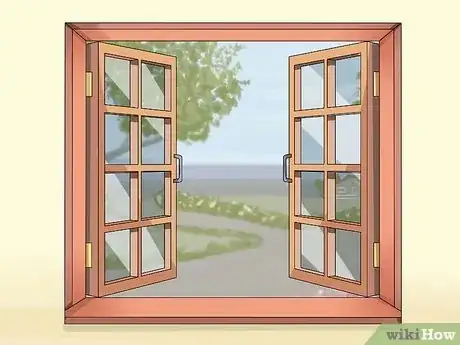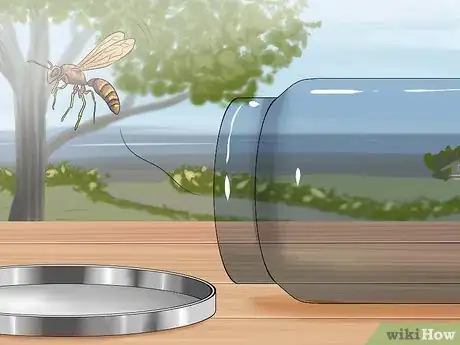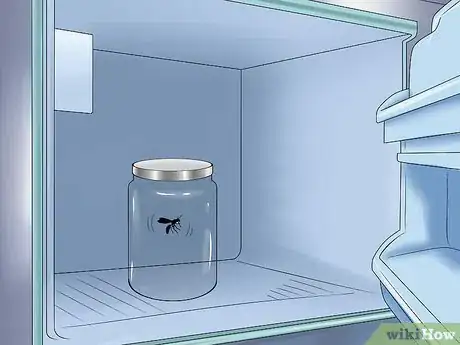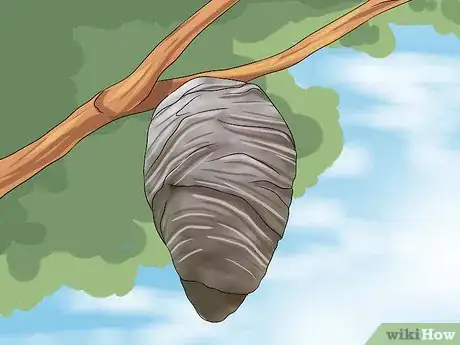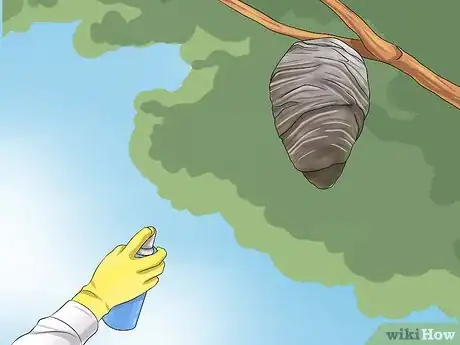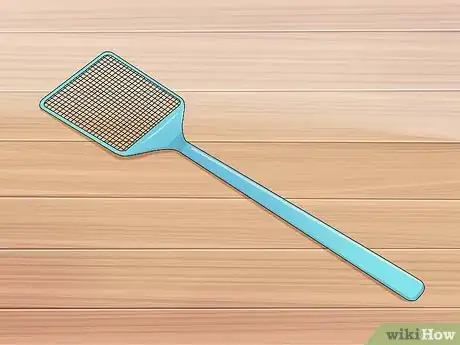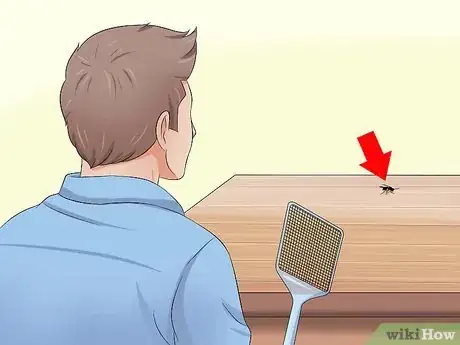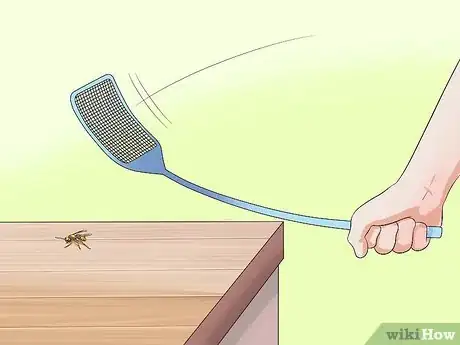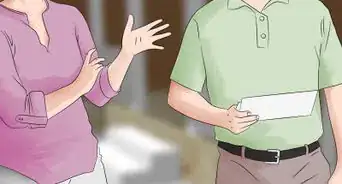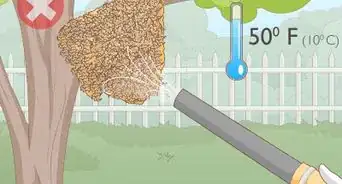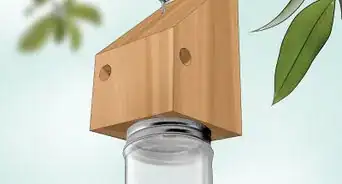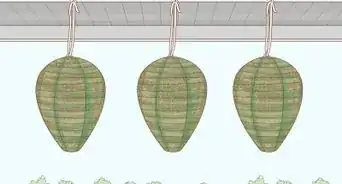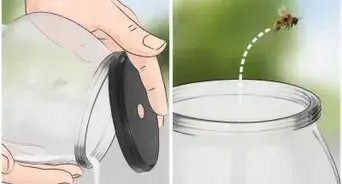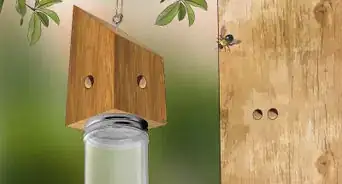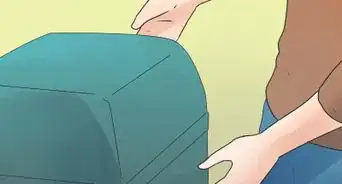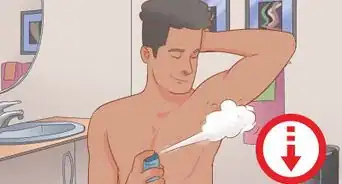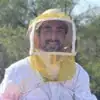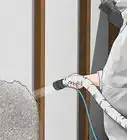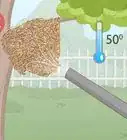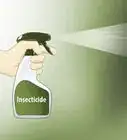This article was co-authored by Steve Downs. Steve Downs is a Live Honey Bee Removal Specialist, Honey bee Preservationist, and the Owner of Beecasso Live Bee Removal Inc, a licensed bee removal and relocation business based in the Los Angeles, California metro area. Steve has over 20 years of humane bee capturing and bee removal experience for both commercial and residential locations. Working with beekeepers, agriculturalists, and bee hobbyists, Steve sets up bee hives throughout the Los Angeles area and promotes the survival of bees. He has a passion for honeybee preservation and has created his own Beecasso sanctuary where rescued bee hives are relocated and preserved.
There are 7 references cited in this article, which can be found at the bottom of the page.
This article has been viewed 246,958 times.
It's important to learn to identify the different types of flying pests before you start swatting away. Honeybees shouldn't be killed, but wasps can be painful and dangerous. Whatever pest has invaded your space, however, you can learn to approach the stinger properly and get it away from you. Learn to relocate bees safely and kill wasps, yellow-jackets, and other nasty pests.
Steps
Trapping and Releasing Bees
-
1Identify the bee first. For some people, anything with a stinger that flies and is yellow and black might as well be called a "bee," but there's a big difference between wasps, yellow-jackets, and honeybees. There's usually no reason to kill a honeybee, so learn the difference between them to deal with pests responsibly.[1]
- Wasps and yellow-jackets are pests with painful stings, usually skinnier, smoother in body and more angular than a honeybee, with small and papery nests. While they help in some ways with insect control, wasps contribute nothing to pollination and–while it may be better to just shoo them out a window–are less important and endangered than honeybees. It's usually ok to swat them occasionally.[2]
- Honeybee populations are endangered in many areas and colonies are struggling to survive. Usually rounded, hairy, and somewhat smaller than wasps, and relatively harmless, honeybees are an essential part of the ecosystem, providing important agricultural pollination. There's no reason to kill a honeybee.
- Try to get a look at the nest. Honey bees build their nests out of wax, in a honeycomb formation, whereas other stinging insects tend to construct their nests out of wood fiber or mud.
-
2Open the windows and doors. If a bee is trapped inside, just open the windows to let them escape . Wait for the bee to pick up the scents and wind currents from outside and find its way back out of your house. If you can, shut the door to the room that the bee is in, trapping it there and go away for an hour or two, giving it plenty of time to find its way out.[3]
- The bee doesn't want to stay in your house and terrorize you. Your house is flower-free and useless to the bee to be inside. Wait for it to leave. When coming back into the room, be cautious until you are certain that the bee has gone.
Advertisement -
3Consider whether it's possible to trap the bee. If you have a small lidded see-through container, use this to try to trap the bee and release it safely outside. It's always preferable to coax a bee away, as opposed to swatting it.
- If you're allergic to bees, it is recommended that you get someone else to do this, or leave the area immediately. If you really have no choice, do this with the utmost care and wear protective gloves and have your epipen easily accessible.
-
4Wait for the bee to land and trap it. Wait until the bee is sitting on a wall or other solid surface and has a chance to calm down some. It's pretty difficult to snatch a quick bee out of the air with a jar, and you might anger it or accidentally kill it otherwise.
- Approach carefully and quickly cup the container over the bee. Wait until the bee flies to the end of the container and quickly snap the lid on, or slide a piece of paper underneath the lip of the container to trap it inside.
-
5Release the bee. Take the bee outside and set it free. Open the lid, back off quickly and wait for it to fly out. Retrieve the container and you're done.
-
6Freeze the bee if you must. If you really need to kill the bee for some reason, place the container in the freezer overnight and let the bee freeze. There's little reason to do this, but it's the most humane method and the simplest.[4]
Dealing with the Nest
-
1Find the hive. An established honey bee colony will sometimes divide itself, and one or more swarms will leave the hive. The new swarm may cluster for a while on a tree limb or bush near the old hive while scout bees search for a suitable place to establish a new home. Usually scout bees find a hollow tree, but occasionally they will choose the wall voids of a home.
- Check under porches with gaps, along areas of new construction in your home, or other places that might house a hive. Anywhere with a large void is a possibility. Bees may nest in the wall or attic some distance from where they enter the wall.
-
2Contact a beekeeper in your area. If honeybees have taken residence in your home or yard and are causing a serious problem, call your local beekeeper's association to see if they will come and collect the bees, since populations are declining. Afterward, you can simply and safely remove the hive and dispose of it without worrying about stings.
- Do not attempt to exterminate the hive with chemicals, and sometimes soap and water. This infuriates the bees and can be very dangerous.
-
3Consider using insecticide, if necessary. If you've discovered honeybees, call a beekeeper and have the bees relocated. If you've discovered wasps, it's usually best to use insecticide to kill them and get them away from your home.
- Once you know the general area of the hive, you can put a water glass on the wall and put your ear to the open end of the glass, and then slowly slide the glass around listening to the buzz behind the wall to locate the precise area occupied by the bee hive. When the nest is located, a hole may be bored, preferably through the outside wall, so insecticide can be applied onto the nest directly.
-
4Spray the nest. Carbaryl or Sevin 5 percent Dust is an insecticide commonly used to exterminate wasps and other pests from dwellings. If it is not applied properly, persistent efforts may be needed to finally accomplish the job.[5]
- Sevin dusted into the entrance to the hive may not reach the nest, which may be some distance from the entrance, so it's important to address the hive itself, not individual wasps and other pests.
- It may take multiple attempts before you kill off the nest completely. Wear protective clothing and take care to avoid painful stings.
-
5Remove the remnants of the nest. Wearing thick clothing and heavy rubber gloves, you can safely dig out the remnants of the nest after the bees have been relocated or the wasps have been killed. If you've sprayed insecticide on the nest, it's important to dispose of it in the garbage, properly. If the bees have been moved, you can dispose of it outdoors without worrying. Take it far from your home and dispose of it.[6]
Killing a Single Pest
-
1Find a flyswatter. If you've got yellow-jackets or wasps that you need to get rid of, the swatting device you usually use for common houseflies is also perfectly usable for wasps and other pests that you might want to stun and get rid of. Cheap plastic flyswatters are perfectly useful in getting rid of wasps.
- Again, there's little reason to kill bees. If they're causing a problem, relocate the hive.
-
2Locate the bee and wait for it to land. Stand still in the general vicinity of the bee and track it. Wait for it to come close to you, with your swatter poised to strike. Wait until the bee lands before you move.
- It's usually a good idea to wait with the swatter raised and poised to swat. If you have to raise the swatter after the bee lands, it's probably going to scare it. Then it's usually too late. Stand as still as possible.
-
3Swat quickly. Flex your wrist to swat the flyswatter forward and stun the bee. If done properly, you may not actually kill the bee, you'll just stun it. Scoop it onto a
- Don't swing at bees in the air. Swatting wildly in the air is a good way to anger a wasp and get yourself a nasty sting.
Community Q&A
-
QuestionWhat do I do if I am allergic to bees?
 Community AnswerFollow the steps in the article, but wear protective clothing. Call in a expert if needed.
Community AnswerFollow the steps in the article, but wear protective clothing. Call in a expert if needed. -
QuestionWhy is freezing a bee to death over a period of hours more humane than swatting it and killing it instantly?
 Community AnswerPerhaps due to the being's sensations while dying. In this case of freezing slowly, the bee would drift off and out of consciousness and not experience pain.
Community AnswerPerhaps due to the being's sensations while dying. In this case of freezing slowly, the bee would drift off and out of consciousness and not experience pain. -
QuestionWhy do they want to hurt people?
 Community AnswerBees don't want to hurt us. Their natural instinct is to sting you if you are causing them problems, or if you are trying to hurt them.
Community AnswerBees don't want to hurt us. Their natural instinct is to sting you if you are causing them problems, or if you are trying to hurt them.
Warnings
- Never mess with bees if you are allergic. Have an epipen with you if you have no choice but to trap or shoo away a bee yourself; it is not recommended that you even try but if you do, be sensible about protecting yourself (gloves, long clothing, anti-allergy medication).⧼thumbs_response⧽
References
- ↑ https://www.pestworld.org/news-hub/pest-articles/stinging-insects-101/
- ↑ https://www.doh.wa.gov/CommunityandEnvironment/Pests/BeesandWasps
- ↑ https://www.ccohs.ca/oshanswers/biol_hazards/bees_wasps.html
- ↑ https://reducing-suffering.org/kill-bugs-humanely/
- ↑ http://www.safebee.com/home/how-get-rid-wasp-or-bee-nest-5-steps
- ↑ http://www.safebee.com/home/how-get-rid-wasp-or-bee-nest-5-steps
- ↑ https://www.livescience.com/4007-bees-recognize-people.html
- ↑ https://www.washingtonpost.com/lifestyle/kidspost/have-you-ever-wondered-why-bees-sting/2017/05/05/4a4aaa90-28fb-11e7-a616-d7c8a68c1a66_story.html?utm_term=.efc433508215
About This Article
If you’re dealing with honeybees, try not to kill them, since they’re an important part of our ecosystem. However, you can kill the wasps and yellow-jackets that give painful stings by hitting them with a fly swatter when they land on a hard surface. Alternatively, try spraying them with insecticide. If you’d rather not kill these insects, just open a window or door to let them escape, or trap them in a jar and release them outdoors. To learn how to distinguish honeybees from wasps and yellow-jackets and what to do with a nest or hive, scroll down!

